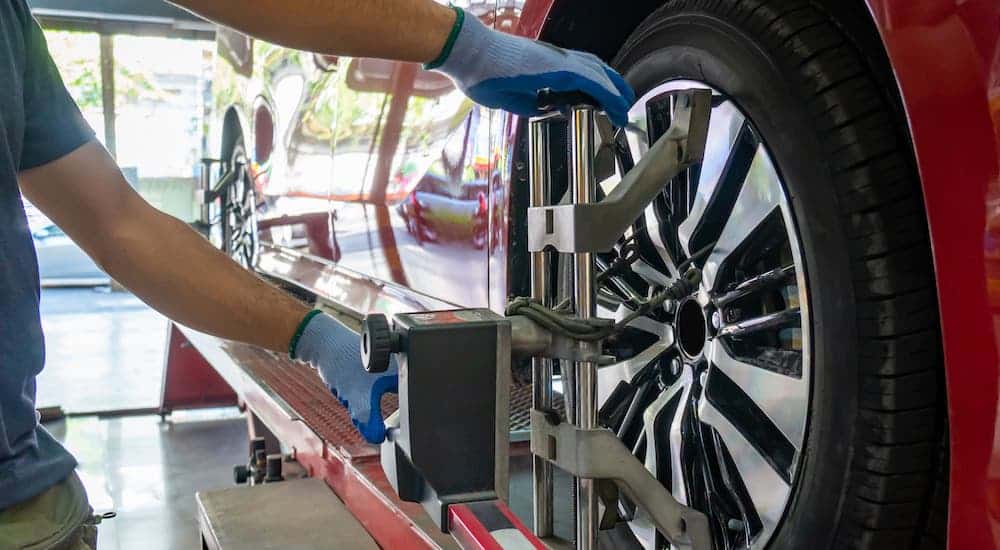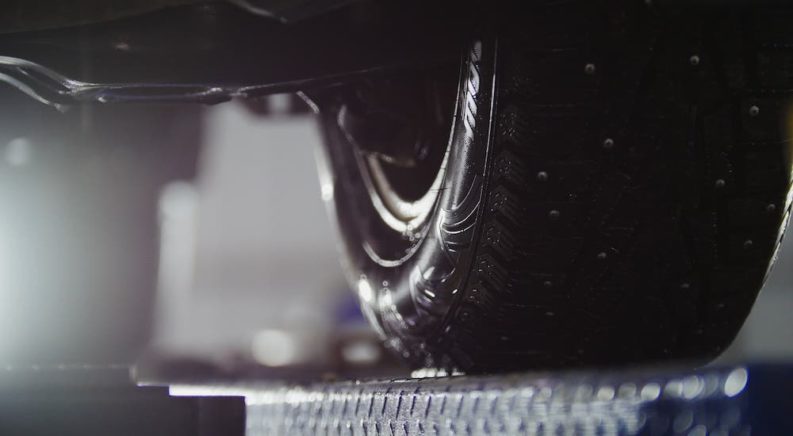Even seasoned do-it-yourself types often think that a wheel alignment is something best left to professionals who have the proper tools and knowledge to do the job correctly. In many respects, this is valid, as modern laser alignment tools used in a professional alignment service will provide a perfect alignment to manufacturer specifications in a short amount of time, but that doesn’t mean doing your own alignment is impossible. If you have patience, some simple tools, and a basic understanding of how cars work, then a DIY alignment is not a difficult task.
There are many reasons why you would want to do your own alignment, ranging from saving money to being able to fine-tune your car’s suspension beyond the manufacturer’s specifications. It is also a valuable skill for anyone who intends to do suspension work on their car, as it will ensure that you will be able to safely drive the car to a properly-equipped shop for a professional alignment. If you don’t feel as though this is a job for you, visit your local alignment service. But if you think you can handle this task, we offer a few tips.
Signs You Need an Alignment
Proper wheel alignment not only extends the life of your tires but also improves vehicle safety and performance. There are several common warning signs that indicate a need for an alignment.
One of the most obvious signs that you need an alignment is when you can feel your vehicle pulling to one side or the other of the road. If you are driving down a straight and smooth surface and you take your hands off of the steering wheel, a misaligned vehicle will pull to the left or to the right. If you drift slightly one way or the other, it might be due to a slope in the road, and your alignment could be fine. It is important you find a straight and even surface to perform this test.
When you are driving down a straight road, take a look at your steering wheel to see if it is at an odd angle. If so, it is a sign that you might need to have your wheels aligned. If you notice that the steering wheel vibrates while you are driving, this is also a sign that you might need an alignment.
Lastly, if your vehicle is out of alignment, your tires will wear quickly and unevenly. This can be happening even if you haven’t experienced the vehicle pulling or the steering wheel off-center. When you inspect your tires for uneven wear, make sure you check the inside of the tire as well as the outside of the tire.

Getting Started
Before you dive into this project, consult your vehicle’s maintenance manual for the proper alignment specs. Even if you intend to fine-tune your alignment, it is important to start with the manufacturer’s recommendations. You will want numbers for toe, camber, and possibly caster. Toe measures the angle at which the tires point in or out. Generally, front-wheel drive cars will want a bit of toe-out, while rear-wheel drive cars will want a bit of toe-in. Camber measures how much the tires slope into the side of the car. Most cars have a bit of negative camber to help in cornering, meaning the wheels slope slightly inwards. Finally, caster measures the angle of the suspension and is not adjustable on most cars.
Aligning Toe
Starting with toe, the theory is pretty simple – you just need to measure how far the tires are from being parallel to each other. Now there are all sorts of tools that can help you measure this, ranging from the really basic all the way up to the extremely expensive laser system at a certified mechanic shop. However, all you really need are some straight edge surfaces and some accurate measuring tapes.
Make sure your car’s steering is centered, and you are on a level surface, then place your straight edges alongside the outsides of your front wheels and measure how far apart they are at the front and rear. Compare those numbers to the factory specs, and you are ready to start making adjustments. Simple! Of course, the devil is in the details. Getting a proper alignment means making sure that all of your numbers are as painstakingly accurate as you can manage. Double, triple, and quadruple check all your measurements and math before making any adjustments to the suspension.
After you are satisfied that your numbers are indeed correct, it is time to put your car up on jack stands – never support a car by a jack alone! To adjust the toe to the proper specifications, locate the tie rod ends under your vehicle and make the necessary adjustments. Loosen the nuts that connect the outer and inner tie rods. The outer tie rod should be turned counterclockwise or loosened if you want to move the wheel inward; turn it clockwise if you want to turn the wheel outward. Remember that both sides of the vehicle need to be adjusted evenly, or you will just make things worse.
After you have made the desired adjustments, never just assume everything is done are you are good to go. Take the car off the jack stands, roll it back and forth a few times to let the suspension settle, and then repeat the entire process. Don’t get discouraged if it takes you awhile – getting a good alignment is all about how much time you invest in the process. Remember how we said patience was necessary?

Aligning Camber and Caster
Camber is not something you are going to need to mess with often, and it is more difficult to adjust. It is still a good idea to check it every so often, but unless you are doing suspension work to your car or setting it up for the track, you probably won’t need to change it. However, measuring camber is fairly simple and requires less math than measuring toe since you don’t have to consider both tires as a single system.
Camber is the vertical angle of your wheels, so you just need something that can measure an angle. One of the easiest ways to do this is to cut a big piece of cardboard into a right triangle, just like a giant carpenter’s square. Place your homemade triangle on the ground, perpendicular to the vehicle up against the wheel. There will be a gap at the top or bottom between your triangle and the tire; measure this gap with a ruler, and you will have your camber. Repeat the process for the other side.
Correcting camber will depend on the vehicle in question, and out of spec camber often indicates a worn or bent part that will need to be replaced. So if you think something is wrong with your camber, we suggest taking it to a professional or at least doing some more research before jumping into a realignment.
The third element of a wheel alignment is caster. Camber is the angle of steering pivot measured in degrees. However, it is not something that is commonly adjustable outside of performance cars or cars with aftermarket suspension. If you have just installed some coilovers with adjustable camber for the first time, your best bet is to set them as close to the factory camber as possible and then slowly adjust them over time as you figure out how your car handles.
You Can Do Your Own Alignment
Wheel alignment is important and should be one of the regular maintenance tasks for your vehicle to keep it in good running order. Not only will a bad alignment cause your tires to wear out rather quickly, but it is also a safety hazard. Most manufacturers recommend that you get an alignment every two to three years, but check your manual for specifics. If you have suffered a little fender bender or hit the curb while driving, have your vehicle checked right away to see if the wheels are misaligned. If you don’t feel confident in doing your own alignment, there is no shame in taking the vehicle in for a pro to work on it – even if you feel you can do it, the pro will get it done much faster.

